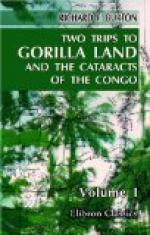Between Ovindo Point, at the northern bend of the stream, stand the so-called “English villages,” divided from the French by marshy ground submerged during heavy rains. The highest upstream is Olomi, Otonda-naga, or town of “Cabinda,” a son of the late king. Next comes Glass Town, belonging to a dynasty which has lasted a century—longer than many of its European brethren. In 1787 a large ship-bell was sent as a token of regard by a Bristol house, Sydenham and Co., to an old, old “King Glass,” whose descendants still reign. Olomi and Glass Town are preferred by the English, as their factories catch the sea-breeze better than can Le Plateau: the nearer swamps are now almost drained off, and the distance from the “authorities” is enough for comfort. Follow Comba (Komba) and Tom Case, the latter called after Case Glass, a scion of the Glasses, who was preferred as captain’s “tradesman” by Captain Vidal, R.N., in 1827, because he had “two virtues which rarely fall to the lot of savages, namely, a mild, quiet manner, and a low tone of voice when speaking.” Tom Qua Ben, justly proud of the “laced coat of a mail coach guard,” was chosen by Captain Boteler, R.N. The list concludes with Butabeya, James Town, and Mpira.
These villages are not built street-wise after Mpongwe fashion. They are scatters of shabby mat-huts, abandoned after every freeman’s death; and they hardly emerge from the luxuriant undergrowth of manioc and banana, sensitive plant and physic nut (Jatropha Curcas), clustering round a palm here and there. Often they are made to look extra mean by a noble “cottonwood,” or Bombax (Pentandrium), standing on its stalwart braces like an old sea-dog with parted legs; extending its roots over a square acre of soil, shedding filmy shade upon the surrounding underwood, and at all times ready, like a certain chestnut, to shelter a hundred horses.
Between the Plateau and Santa Clara, beginning some two miles below the former, are those hated and hating rivals, Louis Town, Qua Ben, and Prince Krinje, the French settlements. The latter is named after a venerable villain who took in every white man with whom he had dealings, till the new colony abolished that exclusive agency, that monopoly so sacred in negro eyes, which here corresponded with the Abbanat of the Somal. Mr. Wilson (p. 252) recounts with zest a notable trick played by this “little, old, grey-headed, humpback man” upon Captain Bouet-Willaumez, and Mr. W. Winwood Reade (chap, xi.) has ably dramatized “Krinji, King George and the Commandant.” On another occasion, the whole population of the Gaboon was compelled by a French man-o-war to pay “Prince Cringy’s” debts, and he fell into disfavour only when he attempted to wreck a frigate by way of turning an honest penny.




